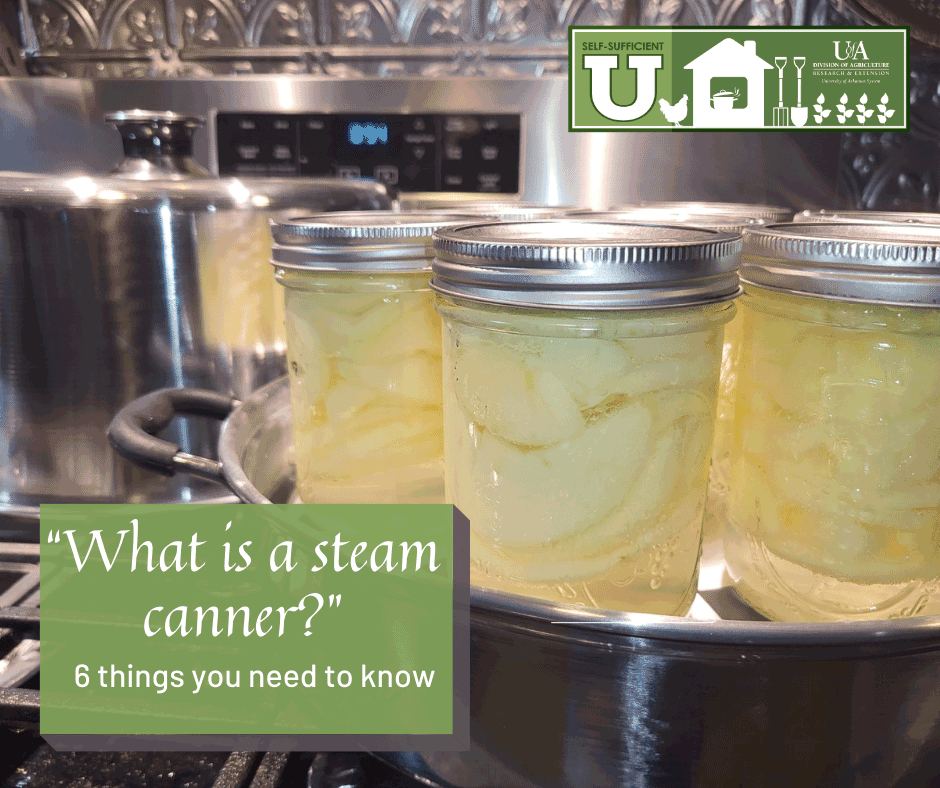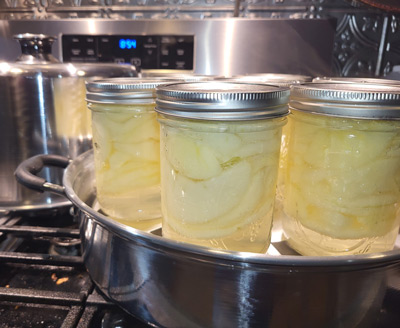What is a steam canner? Is it safe to use?
Contact
Clark County Extension Service
Amy Simpson, Horticulture
Cindy Ham, 4-H and Ag
JoAnn Vann, Family & Consumer Sciences
Phone: 870-246-2281
Email: clark-arkadelphia@uada.edu
Follow us on
Facebook
Clark County
Cooperative Extension Service
640 S 6th Street Suite B
Arkadelphia, AR 71923

6 Things You Need to Know About Steam Canners
By: JoAnn Vann
I love trying out new equipment and processes for safely preserving food! In recent years, steam canning has come onto the scene as a hot topic. A steam canner is a three-piece vessel that includes a water basin, jar rack, and lid with temperature gauge. Is it safe to use? The answer is- it depends! Updated research supports that a steam canner can be safely used in place of a boiling water bath canner for many high acid foods but cannot be used in place of pressure canning for low acid foods.
Need to Know:
- Only high acid foods (pH of 4.6 or lower) can be processed safely in steam canners. These include fruits, jams, jellies, some tomato products, pickled products, and other fruit preserves.
- Only use recipes that have been research-tested as safe for use with steam canning such as those from USDA Complete Guide to Home Canning, the National Center for Home Food Preservation, and the book So Easy to Preserve.
- The recipe processing time cannot exceed 45 minutes. This limitation is due to length of time the water in the reservoir can provide adequate steam without running dry.
- The processing time in a steam canner is the same as listed for a boiling water bath canner in tested recipes. Follow instructions for adjusting for elevation.
- Steam canners must be calibrated for the location of use. Follow the manufacturer's instructions.
- Research recommendations only apply to Back-to-Basics and Victorio steam canner models.
Potential Benefits:
- LESS RESOURCES: Steam canners require less water and thus less energy per batch.*
- LIGHTER: Less water also means less weight on the stove top and to it is easier to move once processing is finished.*
- TIME SAVINGS: Steam canners can reach the required processing temperature much faster than bringing a boiling water bath canner back to a boil after jars are loaded.
*If the recipe instructions call for a processing time of less than 10 minutes, jars must be sterilized prior to use by submersion in boiling water. This cannot be done using the steam canner negating some of the potential benefits.
I caught apples on sale this weekend and decided to run a batch in the steam canner instead of using the traditional boiling water bath canner. I used the Apples-sliced recipe with very light syrup from the National Center for Home Food Preservation. Don’t have a commercially prepared product to prevent the apples from darkening? Chances are you have one of the treatment options listed by our sister organization, Utah State University Extension. I had vitamin c powder in the pantry so that is what I used.
So what were the results?
 The finished product looked the same as when processed in the boiling water bath canner
and I did not have any lid failures in the batch.
The finished product looked the same as when processed in the boiling water bath canner
and I did not have any lid failures in the batch.
As long as I select a recipe with a processing time exceeding 10 minutes so I do not have to pre-sterilize the jars, I preferred using the steam canner over the boiling water bath canner because of the quick heating time and the reduced weight of handling the canner because less water is used.
It only took 4 minutes for the steam canner to reach processing temperature once the jars were loaded. However, if I choose a recipe with less than 10 minutes of processing time, I would rather use my boiling water bath canner to sterilize the jars while I am preparing the recipe and then finish in the boiling water bath canner since it is already hot and ready to go.
The steam canner is more compact requiring less storage space compared to a boiling water bath canner.
The needs of the individual, type of food, time spent canning, and energy sources are all important considerations. Steam canning may or may not be a method that meets your needs, but I hope this article has provided you with the information to make an informed decision that adds value to your food preservation efforts.
For more information on safe food preservation, check out our Arkansas Extension website to find your local county agent and food preservation resources. For more information on steam canning, download SteamCannerGuidelinesFeb2019.pdf (wisc.edu) and An update on safe use of steam canners – Extension Columbia County (wisc.edu).
Interested in hands-on learning opportunities?
Join our Self-Sufficient U e-newsletter list and like our Facebook page to get food preservation workshop and other event announcements.